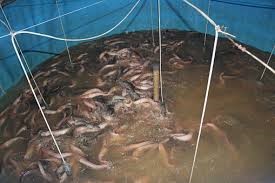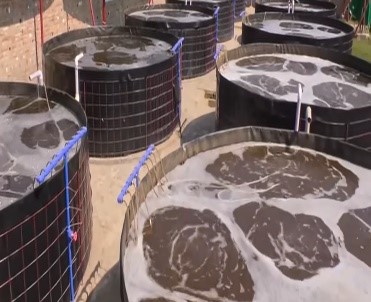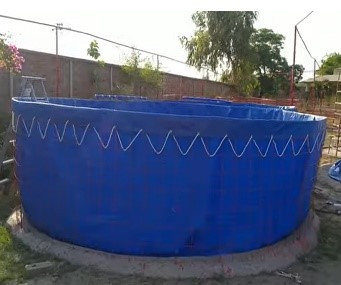INP-WealthPk
Faiza Tehseen
Pakistan can enhance its export of fish, shrimps, and other fishery products by introducing smart technologies like Bio Flock Fish Farming Technique (BFT). Increased fish production can help not only fetch a lot of precious foreign exchange but also meet domestic food needs.

Discussing with WealthPK the economic value and importance of BFT, Principal Research Officer at the Khyber Pakhtunkhwa Agricultural Research System Dr. Muhammad Shah Sawar said, “BFT is the most economic, space-saving, and easy-to-handle way of commercial fish rearing. About 700 to 1,000 fish can be reared in a tank of 10 cubic meters or a tank with a capacity of 10,000 liters. The same capacity can be harvested from a farm established in an area of 43560 sq. ft. (an acre app).’’

‘’BFT is environment-friendly, as whenever a large pond is established on earth, it disturbs the water table and also causes salination. In BFT aquaculture, water quality is improved by balancing the amounts of Carbon (C) and Nitrogen (N) to produce autogenerated proteinaceous feed in the water. It is very helpful for the fish species to grow faster. Actually, in this system, the water is inoculated with multiple bacterial strains and microorganisms, such as zooplankton, protozoa, and algae that form groups called ‘flocs.’ That’s why it is named bio floc. They also act as biological bunches and keep the feed floating, which makes it easy for the fish to eat rather than it stocks at the bottom and is mostly wasted.
Adjacent oxygen tanks keep the oxygen level controlled in a BFT tank, so water is not regularly needed to be changed.’’ ‘’Almost all types of carp, salmon, shrimp, and trout can be reared easily in bio fish flock tanks. Tilapia especially best adapts to the bio-floc environment and produces a high yield. A tank of BFT covers 272.3 sq. ft. (app a marla) of area. It can be easily placed in the backyard. It is not much labour-intensive, so the housewives can manage it.
Live fish makes 30-40% more money than the fish stocks brought to the market from other cities. Sometimes, they are washed with unhealthy chemicals to keep them fresh and odourless,’’ said Dr Shah. Continuing the discussion, he said a small unit, including two ponds and gadgets, costs around Rs175,000 to Rs200,000. “About eight to nine months into the growth cycle, you can harvest fish weighing 1 kg to 1.50 kg,” he said. After deducing all production costs, about 80,000 to 100,000 PKR can be earned as net profit from each unit, he added.

Talking to WealthPK, Director of Marine Fisheries, Lasbella, Balochistan Dr. Ahmad Nadeem said, “It is a totally new and advanced technology suitable to produce more fish in a small place. A tank with a capacity of 500 to 1,000 gallons of water or more than this capacity can also be used to rear fish. Tanks can be made from any leak-proof material, i.e. polystyrene styrofoam, plastic, polyethylene, fiberglass, etc.
They can be of any shape. These days BFT is the top trend in the fisheries business. After 6 to 7 months, you can get fish of about 500 grams. It can be a constraint in the local market, as domestic consumers mostly like the least weight of 1kg, but it is much tasty. In the international market, however, it is considered the best weight because globally small sized fish is appreciated.’’ Dr Nadeem said, ‘’Proper oxygen supervision and seed supply guarantee a good and weighty yield from this system.
Proper electricity supply is also an important component of this BFT aquaculture. Solar panels can also be used for this purpose. Chinese carp, Indian carp, tilapia, and especially shrimps are ideal to grow through BFT. It is a sustainable source of earning for both domestic and commercial use. This system can be started in the backyard or on the roof. No specific skill is needed to manage it, so women can also do it.’’
‘’BFT is very popular in countries like China and South Korea. It is important to introduce in Balochistan like in other parts of the country. It is not regularized at the provincial government level, but it is part of a plan to start it as a sustainable economic and food source,” he said.
“Growing demand for aquatic food globally is a good chance for Pakistan to get its slice of profit earnings. Subsidies to promote aqua-cultural techniques in the country will help establish this industry. It will also encourage people to invest in this sector. This new addition to the already performing fisheries business will also act as a sustainable livelihood source by generating more work and job opportunities,’’ he added.
Credit: Independent News Pakistan-WealthPk



